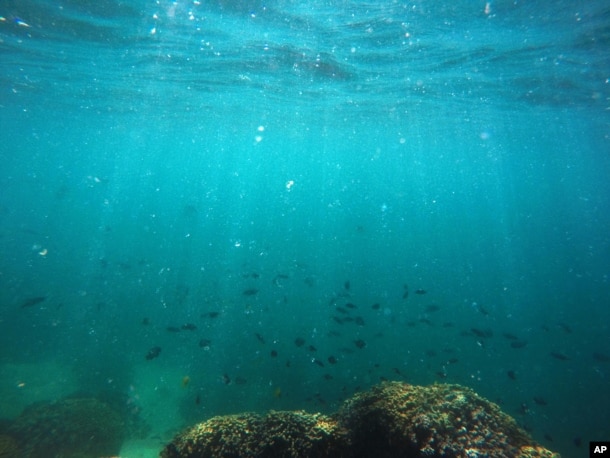World’s Seas Getting Better Protection

Steve Herman
VOA News
STATE DEPARTMENT — More than 120 ocean conservation projects, including nearly $2 billion in new pledges and commitments, are being announced at a major maritime conference hosted by the U.S. State Department.
Officials say the measures will affect more than 2 million square kilometers in new or expanded marine protected areas around the world. Governments attending the previous Our Ocean conferences in 2014 and 2015 had committed to protect nearly 6 million square kilometers of the ocean – an area more than twice the size of India.
Stating that “my administration has protected more waters than any in history” President Barack Obama told those attending the third Our Ocean conference on Thursday that a lot more needs to be done as the chemistry of the ocean changes and sea levels rise, threatening to sink livelihoods and entire communities.
“It’s happening as we speak. It’s happening in America,” Obama told the audience at the State Department.
New marine monuments
“I know that in a contest between us and the ocean, the ocean will win one way or another, so it’s us that has to adapt. Not the other way around,» the president said while adding he remains optimistic that those in the room could rise to the challenge because “these are problems we can solve.”
Obama announced Wednesday that he has established the first national marine monument in the Atlantic Ocean, the Northeast Canyons and Seamounts Marine National Monument, off of the coast of the state of Massachusetts.
Obama last month expanded the Papahanaumokuakea Marine National Monument, northwest of the Hawaiian islands, containing extensive coral reefs, using the 1906 Antiquities Act, which allows a president to take unilateral action.
“We’re here because we have to do more and we have to do it faster,” Secretary of State John Kerry said at the event’s opening, pointing out that there are now 500 dead zones in the world’s seas where “life simply cannot exist.”
“Oceans are really the piece of the environment that is buffering our planet against future climate change and we really need to put a lot more energy and invest a lot more in protecting it in keeping it healthy,” marine biologist Lance Morgan, who is the president of the Marine Conservation Institute, told VOA.
The conference, Morgan said, helps to raise the profile of what covers 70 percent of the planet’s surface but gets nowhere near that portion of the human occupants’ attention.
“People don’t have the same intimacy with the ocean that they do with the land and so it’s out of sight, out of mind,” says Morgan, who is also chairman of the board of the Deep Sea Conservation Coalition.
“Meetings like this, where high-profile politicians and other leaders and others around the world get invested in the oceans, is a way of raising oceans on the agenda and really pointing out the importance of that. To many people, oceans can be a scary place but they’re really critical to our healthy planet.”

FILE – Fish swim over a patch of bleached coral in Hawaii’s Kaneohe Bay off the island of Oahu. Hawaii, Oct. 26, 2015.
Overfishing, degraded reefs
Marine Scientist Caleb Mclennen recounted the impact that humans have had on ocean life.
“The ocean has lost 95 percent of ocean predators, a third of coral reefs are degraded, and over half the world’s fisheries are fully exploited or over exploited. This problem is increasingly acute in developing countries, where marine protected areas (MPAs) have been shown to boost fish biomass, increase the resilience of marine ecosystems and boost local economies,” McClennen told VOA.
McClennen, who is the vice president of global conservation programs for the Wildlife Conservation, added that a $48 million combined commitment from WCS, the Waitt Foundation, the Blue Moon Fund and the Global Environment Facility “will support efforts to expand and improve MPAs where they are critically needed, in the exclusive economic zones of developing countries world-wide.”
Only three percent of the ocean is part of a marine protected area (MPA) and less than one percent is fully protected in a marine reserve. MPAs cover about 32 percent of U.S. marine waters and three percent of American waters are fully protected.
New technology to monitor fishing fleets
The conference is not only focused on environmental issues. Illegal, unreported and unregulated fishing is another major concern.
Actor Leonardo DiCaprio unveiled at the conference a new, free technology he partly funded that will allow users to monitor global fishing practices.
“I encourage everyone to check it out,” DiCaprio said.
Combing satellite technology combined with radar on vessels, the onlineGlobalFishingWatch.org will allow anyone with an Internet connection to trace the paths of thousands of commercial boats in an attempt to curb illegal fishing.
On the eve of the gathering the State Department’s Trafficking in Persons (TIP) office and the non-profit Freedom Fund announced a partnership to combat human trafficking, initially in the seafood sector in Southeast Asia.
Kerry, in earlier remarks Wednesday evening (to the Oceana Global Fishing Watch reception), highlighted the use of human slaves to fish illegally.
“So human trafficking is part of this,” Kerry said. “Narcotics smuggling is part of this. Criminal enterprises moving and trafficking in guns. Because it’s all criminal activity. It’s all big money. It’s all under the table.”
Kerry returned to the topic in his opening remarks Thursday, telling delegates “we need to make sure no patch of ocean is beyond the law.”

